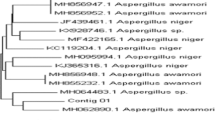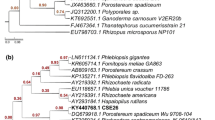Abstract
Aspergillus oryzae NRRL 35191 was isolated as an endophyte from coffee leaves and found to produce kojic acid (KA) in culture. When inoculated into cacao seedlings (Theobroma cacao), A. oryzae grew endophytically and synthesized KA in planta. Cacao seedlings inoculated with A. oryzae produced higher levels of caffeine than non-inoculated ones. Aspergillus oryzae may be a useful endophyte to introduce to cacao since it grows non-pathogenically and induces the caffeine defense response that may make the plant more tolerant to insects and pathogens.


Similar content being viewed by others
References
Alverson J (2003) Effects of mycotoxins, kojic acid and oxalic acid, on biological fitness of Lygus hesperus (Heteroptera: Miridae). J Invertebr Pathol 83:60–62
Aneja M, Gianfagna TJ (2001) Induction and accumulation of caffeine in young, actively growing leaves of cocoa (Theobroma cacao L.) by wounding or infection with Crinipellis perniciosa. Physiol Mol Plant Pathol 59:13–16
Arnold E, Mejia LC, Kyllo D, Rojas EI, Maynard Z, Robbins N, Herre EA (2003) Fungal endophytes limit pathogen damage in a tropical tree. Proc Natl Acad Sci USA 100:15649–15654
Bentley R (2006) From miso, sake and shoyu to cosmetics: a century of science for kojic acid. Nat Prod Rep 23:1046–1062
Burdock GA, Soni MG, Carabin IG (2001) Evaluation of health aspects of kojic acid in food. Regul Toxicol Pharmacol 33:80–101
Cao L, Qiu Z, You J, Tan H, Zhou S (2005) Isolation and characterization of endophytic streptomycete antagonists of Fusarium wilt pathogen from surface-sterilized banana roots. FEMS Microbiol Lett 247:147–152
Clarke BB, White JF Jr, Hurley RH, Torres MS, Sun S, Huff DR (2006) Endophyte-mediated suppression of dollar spot disease in fine fescues. Plant Dis 90:994–998
Cleveland TE, Dowd PF, Desjardins AE, Bhatnagar D, Cotty PJ (2003) United States Department of Agriculture–Agricultural Research Service research on pre-harvest prevention of mycotoxins and mycotoxigenic fungi in U.S. crops. Pest Manag Sci 59:629–642
Cole RJ, Schweikert MA (2003) Handbook of secondary fungal metabolites. Academic, San Diego
Dowd PF (1999) Relative inhibition of insect phenoloxidase by cyclic fungal metabolites from insect and plant pathogens. Nat Toxins 7:337–341
Dowd PF (2002) Antiinsectan compounds derived from microorganisms. In: Koul O, Dhaliwal GS (eds) Microbial biopesticides. Taylor & Francis, New York, pp 13–115
Geiser DM, Dorner JW, Horn BW, Taylor JW (2000) The phylogenetics of mycotoxin and sclerotium production in Aspergillus flavus and Aspergillus oryzae. Fungal Genet Biol 31:169–179
Guo B, Wang Y, Sun X, Tang K (2008) Bioactive natural products from endophytes: a review. Appl Biochem Microbiol 44:136–142
Kay E, Bertolla F, Vogel TM, Simonet P (2002) Opportunistic colonization of Ralstonia solanacearum-infected plants by Acinobacter sp. and its natural competence development. Microb Ecol 43:291–297
Keller NP, Turner G, Bennett JW (2005) Fungal secondary metabolism – from biochemistry to genomics. Nat Rev Microbiol 3:937–946
Klich MA (2007) Aspergillus flavus: the major producer of aflatoxin. Mol Plant Pathol 8:713–722
Kurtzman CP, Smiley MJ, Robnett CJ, Wicklow DT (1986) DNA relatedness among wild and domesticated species of the Aspergillus flavus group. Mycologia 78:955–959
Leger RJSt, Screen SE, Shams-Pirzadeh B (2000) Lack of host specialization in Aspergillus flavus. Appl Environ Microbiol 66:320–324
Peterson SW, Ito Y, Horn BW, Goto T (2001) Aspergillus bombycis, a new aflatoxigenic species and genetic variation in its sibling species, A. nomius. Mycologia 93:689–703
Rubini MR, Silva-Ribeiro RT, Pomella AWV, Maki CS, Araújo WL, Santos DR, Azevedo JL (2005) Diversity of endophytic fungal community of cacao (Theobroma cacao L.) and biological control of Crinipellis perniciosa, causal agent of witches' broom disease. Int J Biol Sci 1:24–33
Schulz B, Boyle C (2005) The endophytic continuum. Mycol Res 109:661–686
Serra R, Peterson SW (2007) Penicillium astrolabium and Penicillium neocrassum, two new species isolated from grapes and their phylogenetic placement in the P. olsonii and P. brevicompactum clade. Mycologia 99:78–87
United States Environmental Protection Agency (1997) Biotechnology Program Under Toxic Substances Control Act. Aspergillus oryzae Final Risk Assessment. http://www.epa.gov/oppt/biotech/pubs/fra/fra007.htm
Van Wees SCM, Van der Ent S, Pieterse CMJ (2008) Plant immune responses triggered by beneficial microbes. Curr Opin Plant Biol 11:443–448
Vega FE, Posada F, Peterson SW, Gianfagna TJ, Chaves F (2006) Penicillium species endophytic in coffee plants and ochratoxin A production. Mycologia 98:37–48
Vega FE, Simpkins A, Aime MC, Posada F, Peterson SW, Rehner SA, Infante F, Castillo A, Arnold AE (2010) Fungal endophyte diversity in coffee plants from Colombia, Hawai’i, Mexico, and Puerto Rico. Fungal Ecol 3:122–138
White JF Jr, Morgan-Jones G (1996) Morphological and physiological adaptations of Balansiae and trends in the evolution of grass endophytes. In: Redlin SC, Carris LM (eds) Endophytic fungi in grasses and woody plants: systematics, ecology, and evolution. APS, St. Paul, Minnesota, pp 133–154
Acknowledgements
To CAPES (Coordenação de Aperfeiçoamento de Pessoal de Nível Superior) for providing F.C. Chaves with a graduate fellowship. To Dr. Joan Bennett for her valuable review of this manuscript.
Author information
Authors and Affiliations
Corresponding author
Rights and permissions
About this article
Cite this article
Chaves, F.C., Gianfagna, T.J., Aneja, M. et al. Aspergillus oryzae NRRL 35191 from coffee, a non-toxigenic endophyte with the ability to synthesize kojic acid. Mycol Progress 11, 263–267 (2012). https://doi.org/10.1007/s11557-011-0745-2
Received:
Revised:
Accepted:
Published:
Issue Date:
DOI: https://doi.org/10.1007/s11557-011-0745-2




